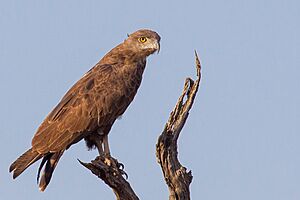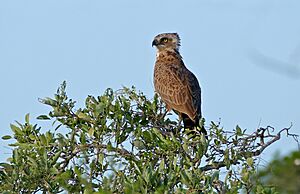Brown snake eagle facts for kids
Quick facts for kids Brown snake eagle |
|
|---|---|
 |
|
| Adult in Madikwe GR, South Africa | |
| Conservation status | |
| Scientific classification | |
| Genus: |
Circaetus
|
| Species: |
cinereus
|
The brown snake eagle (Circaetus cinereus) is a large bird of prey. It belongs to the family Accipitridae. You can find this eagle in West, East, and southern Africa. This bird mostly eats snakes.
The brown snake eagle is a very solitary bird. It has a long breeding cycle and usually raises only one young eaglet. Even though it might not be super common, it lives across a very wide area. Because of this, it is listed as a least concern species, meaning it's not currently endangered.
Contents
Where Brown Snake Eagles Live
Brown snake eagles live across a large part of Africa. You can find them in many countries. These include places like Senegal and Nigeria in West Africa. They also live in Ethiopia and Kenya in East Africa. Further south, they are found in Botswana and South Africa.
These eagles don't usually migrate far. But they can be a bit nomadic, meaning they move around within their home range. Some have been known to travel over 200 km (120 mi). One ringed bird even traveled 2,100 km (1,300 mi) from South Africa to the Democratic Republic of the Congo!
Brown snake eagles prefer open woodlands and savanna areas. They often like places with small hills or valleys. They can live anywhere from sea level up to 2,000 m (6,600 ft) high.
What Brown Snake Eagles Look Like
Brown snake eagles are mostly dark brown. Their body feathers are a deep hazel brown. Their flight feathers, which are the long feathers on their wings, are a lighter whitish-grey. These lighter feathers stand out against their dark body.
Their tail is short and has brown and grayish-cream bars. You can see this best when they are flying. Young eagles look similar to adults. They might have some white spots, especially on their belly and head.
This eagle has a large head and bare legs. These features help tell it apart from other brown eagles. It is the largest type of eagle in its group, the Circaetus genus.
Brown snake eagles are quite large. They can be from 66 to 78 cm (26 to 31 in) long. Their wingspan can reach from 160 to 185 cm (5 ft 3 in to 6 ft 1 in). Some might even have wingspans up to 200 cm (6 ft 7 in). They usually weigh between 1.5 and 2.5 kg (3.3 and 5.5 lb).
Their call is a rough, guttural sound, like hok-hok-hok-hok. They often make this sound when defending their territory. Sometimes it ends with a crowing kaaww. Pairs might also make a soft kwee-oo sound to keep in touch near the nest.
Brown Snake Eagle Habits

Brown snake eagles are bigger and stronger than other snake eagles. This means they can catch larger prey. They eat almost any reasonably sized snake. This includes both harmless and venomous snakes. Like other snake eagles, they have thick-skinned legs. This helps protect them from snake bites.
At one nest in Zimbabwe, three out of four snakes found were venomous. These included boomslangs, puff adders, and black-necked spitting cobras. The eagles often remove the snake's head before bringing it to the nest. They can even catch large puff adders weighing about 750 g (1.65 lb). There are even stories of them hunting large black mambas, some as long as 2.8 m (9 ft 2 in).
These eagles usually hunt from a high spot, like a tree branch or a small hill. They almost always catch their prey on the ground. Like most snake eagles, they often swallow their prey whole. But if a snake is very large, they will tear it into pieces.
Sometimes, they eat other animals too. This can include monitor lizards, toads, francolins, guineafowl, and even chickens. They might also eat rats and other small mammals.
Breeding and Young Eagles
Brown snake eagles are solitary birds. Even a breeding pair is rarely seen together outside of the nesting period. The male eagle does most of the display flights to show off his territory. These flights can be quite acrobatic.
They build their nests on flat-topped trees like Acacia or Euphorbia. The nests are usually about 60 to 70 cm (24 to 28 in) wide and 15 to 30 cm (5.9 to 11.8 in) deep. They are often built 3.5 to 11 m (11 to 36 ft) above the ground. Sometimes, they use old nests built by other large birds of prey.
The female eagle lays only one egg. She incubates it for about 50 days, which is quite a long time for an eagle of this size. The female mostly stays on the nest to keep the egg warm. The male brings food to her and later to the chick.
When the male brings a snake, he often carries it with just the tail hanging out of his mouth. The female then pulls the snake out. She tears the snake into small pieces for the single eaglet. The young eagle stays near the nest for 60 to 100 days. It then starts exploring nearby branches. It learns to fly, or fledges, at about 97 to 113 days old.
After fledging, the young brown snake eagle becomes independent in a few weeks. Even though it might still beg for food, the parents soon stop feeding it. These eagles typically live for about 7 to 10 years.
The brown snake eagle is not very common. Its numbers might be slowly decreasing. However, it still lives across a very large area. Because of this, it is currently listed as a species of "least concern" for conservation.
Images for kids
-
Brown snake eagle drinking water in Yankari National Park, Bauchi, Nigeria.




